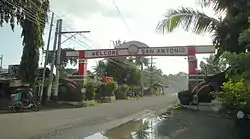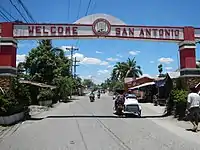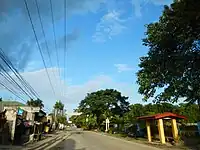San Antonio | |
|---|---|
| Municipality of San Antonio | |
 Welcome arch | |
 Flag  Seal | |
 Map of Nueva Ecija with San Antonio highlighted | |
OpenStreetMap | |
.svg.png.webp) San Antonio Location within the Philippines | |
| Coordinates: 15°18′28″N 120°51′12″E / 15.3078°N 120.8533°E | |
| Country | Philippines |
| Region | Central Luzon |
| Province | Nueva Ecija |
| District | 4th district |
| Named for | St. Anthony the Abbot |
| Barangays | 16 (see Barangays) |
| Government | |
| • Type | Sangguniang Bayan |
| • Mayor | Arvin C. Salonga |
| • Vice Mayor | Julieta E. Maxwell |
| • Representative | Emerson D. Pascual |
| • Municipal Council | Members |
| • Electorate | 57,256 voters (2022) |
| Area | |
| • Total | 153.56 km2 (59.29 sq mi) |
| Elevation | 17 m (56 ft) |
| Highest elevation | 32 m (105 ft) |
| Lowest elevation | 10 m (30 ft) |
| Population (2020 census)[3] | |
| • Total | 83,060 |
| • Density | 540/km2 (1,400/sq mi) |
| • Households | 20,527 |
| Economy | |
| • Income class | 1st municipal income class |
| • Poverty incidence | 5.80 |
| • Revenue | ₱ 265.8 million (2020) |
| • Assets | ₱ 469.9 million (2020) |
| • Expenditure | ₱ 265.5 million (2020) |
| • Liabilities | ₱ 218.8 million (2020) |
| Service provider | |
| • Electricity | Nueva Ecija 1 Electric Cooperative (NEECO 1) |
| Time zone | UTC+8 (PST) |
| ZIP code | 3108 |
| PSGC | |
| IDD : area code | +63 (0)44 |
| Native languages | Kapampangan Tagalog Ilocano |
| Website | www |
San Antonio, officially the Municipality of San Antonio (Tagalog: Bayan ng San Antonio, Kapampangan: Balen ning San Antonio), is a 1st class municipality in the province of Nueva Ecija, Philippines. According to the 2020 census, it has a population of 83,060 people.[3]
Etymology
The present name of the town was given in 1843 in honor of the patron saint, San Antonio Abad, by Father Leocadio Luis, the first priest of the town. Before its organization and recognition as a town by means of a decree promulgated during the Spanish regime, this was a barangay of Gapan and was known as Barrio Delinquente.
History
San Antonio was previously called as the barrio of Delinquente as old residents claimed that the name Delinquente originated by the sinking of a Casco (big boat or banca) fully loaded with palay in Pampanga River.
It was partitioned from the town of Gapan in 1843 by the order of Governor-General Marcelino Oraa, along with the town of San Isidro. The movement of the separation of Barrio Delinquente from the town of Gapan, and its organization as an independent municipality was ignited in 1839. The petition of the residents of Barrio Delinquente was finally approved in November 1842 but the definite separation from the town of Gapan took place in 1843.
It is bounded by the towns of Jaen to its eastern side, Zaragosa is to the north, Cabiao and San Isidro, and Concepcion in the Province of Tarlac is at its western border.
Travelling from the Philippine capital city of Manila, a popular route going to San Antonio is via the North Luzon Expressway (NLEX). Turning north-east and exiting the NLEX at the San Simon junction, the journey continues to Arayat, the last town of Pampanga before reaching Cabiao. From Cabiao, one can opt to continue towards the town of San Isidro and then take a left turn towards Jaen and then before Jaen town proper take another turn towards San Antonio. There is an alternative backroad route leading to the southern part of San Antonio and this can be taken immediately after entering Brgy. Concepcion, turning left towards the Santa Isabel Bridge which crosses the Pampanga river.
The older and now slower route is the bus transport route which leaves the NLEX at Santa Rita and traverses the Pan-Philippine Highway across the length of the Province of Bulacan up to Gapan in Nueva Ecija and turning left on the Gapan-Olongapo Road.
Geography
Barangays
San Antonio is politically divided into 16 barangays. Each barangay consists of puroks and some have sitios.
- Buliran
- Cama Juan
- Julo
- Lawang Kupang
- Luyos
- Maugat
- Panabingan
- Papaya
- Poblacion
- San Francisco (KC-1) Kaisiwan
- San Jose (Cabungan)
- San Mariano
- Santa Barbara
- Santa Cruz (Parang)
- Santo Cristo
- Tikiw
Climate
| Climate data for San Antonio, Nueva Ecija | |||||||||||||
|---|---|---|---|---|---|---|---|---|---|---|---|---|---|
| Month | Jan | Feb | Mar | Apr | May | Jun | Jul | Aug | Sep | Oct | Nov | Dec | Year |
| Mean daily maximum °C (°F) | 28 (82) |
30 (86) |
31 (88) |
33 (91) |
33 (91) |
31 (88) |
30 (86) |
29 (84) |
29 (84) |
30 (86) |
30 (86) |
29 (84) |
30 (86) |
| Mean daily minimum °C (°F) | 20 (68) |
20 (68) |
20 (68) |
22 (72) |
24 (75) |
24 (75) |
24 (75) |
24 (75) |
24 (75) |
23 (73) |
22 (72) |
21 (70) |
22 (72) |
| Average precipitation mm (inches) | 4 (0.2) |
4 (0.2) |
5 (0.2) |
11 (0.4) |
66 (2.6) |
99 (3.9) |
127 (5.0) |
113 (4.4) |
99 (3.9) |
84 (3.3) |
35 (1.4) |
14 (0.6) |
661 (26.1) |
| Average rainy days | 2.2 | 1.9 | 3.2 | 5.3 | 16.1 | 20.8 | 23.5 | 22.8 | 22.2 | 16.5 | 8.9 | 3.5 | 146.9 |
| Source: Meteoblue[5] | |||||||||||||
Demographics
|
| |||||||||||||||||||||||||||||||||||||||||||||||||||
| Source: Philippine Statistics Authority[6][7][8] | ||||||||||||||||||||||||||||||||||||||||||||||||||||
Economy
Government
Local government
Municipal elected official (2022–present):
- Mayor
- Arvin Salonga
- Vice Mayor
- Julie Maxwell
- Councilors:
- Roberto Carpio
- Manolito Balcos
- Daniel Pamintuan
- Christopher Cunanan
- Renier Umali
- Eduardo Ostares
- RC Cruz
- Roy Juliano
Gallery
 Welcome arch
Welcome arch Highway
Highway Town hall
Town hall Saint Anthony Abbot Parish Church
Saint Anthony Abbot Parish Church Public Market
Public Market
References
- ↑ Municipality of San Antonio | (DILG)
- ↑ "2015 Census of Population, Report No. 3 – Population, Land Area, and Population Density" (PDF). Philippine Statistics Authority. Quezon City, Philippines. August 2016. ISSN 0117-1453. Archived (PDF) from the original on May 25, 2021. Retrieved July 16, 2021.
- 1 2 Census of Population (2020). "Region III (Central Luzon)". Total Population by Province, City, Municipality and Barangay. Philippine Statistics Authority. Retrieved 8 July 2021.
- ↑ "PSA Releases the 2018 Municipal and City Level Poverty Estimates". Philippine Statistics Authority. 15 December 2021. Retrieved 22 January 2022.
- ↑ "San Antonio: Average Temperatures and Rainfall". Meteoblue. Retrieved 4 May 2020.
- ↑ Census of Population (2015). "Region III (Central Luzon)". Total Population by Province, City, Municipality and Barangay. Philippine Statistics Authority. Retrieved 20 June 2016.
- ↑ Census of Population and Housing (2010). "Region III (Central Luzon)" (PDF). Total Population by Province, City, Municipality and Barangay. National Statistics Office. Retrieved 29 June 2016.
- ↑ Censuses of Population (1903–2007). "Region III (Central Luzon)". Table 1. Population Enumerated in Various Censuses by Province/Highly Urbanized City: 1903 to 2007. National Statistics Office.
{{cite encyclopedia}}: CS1 maint: numeric names: authors list (link) - ↑ "Poverty incidence (PI):". Philippine Statistics Authority. Retrieved December 28, 2020.
- ↑ "Estimation of Local Poverty in the Philippines" (PDF). Philippine Statistics Authority. 29 November 2005.
- ↑ "2003 City and Municipal Level Poverty Estimates" (PDF). Philippine Statistics Authority. 23 March 2009.
- ↑ "City and Municipal Level Poverty Estimates; 2006 and 2009" (PDF). Philippine Statistics Authority. 3 August 2012.
- ↑ "2012 Municipal and City Level Poverty Estimates" (PDF). Philippine Statistics Authority. 31 May 2016.
- ↑ "Municipal and City Level Small Area Poverty Estimates; 2009, 2012 and 2015". Philippine Statistics Authority. 10 July 2019.
- ↑ "PSA Releases the 2018 Municipal and City Level Poverty Estimates". Philippine Statistics Authority. 15 December 2021. Retrieved 22 January 2022.
- ↑ "San Antonio - Nueva Ecija | Eleksyon 2022 | GMA News Online".
